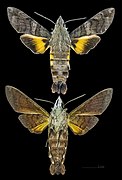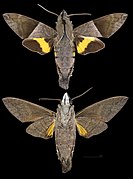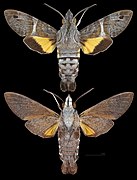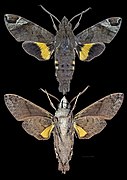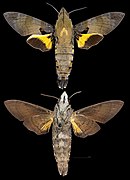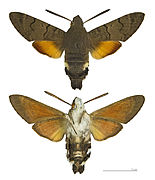Macroglossum
| Macroglossum | ||||||||||
|---|---|---|---|---|---|---|---|---|---|---|
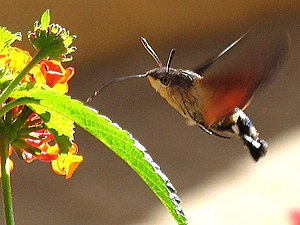
Pigeon tail ( Macroglossum stellatarum ) |
||||||||||
| Systematics | ||||||||||
|
||||||||||
| Scientific name | ||||||||||
| Macroglossum | ||||||||||
| Scopoli , 1777 |
Macroglossum is a genus within the butterfly family of swarmers (Sphingidae).
features
The head is broad and has no noticeable tufts of hair. The snout is very long and triangular in shape. The antennae are club-shaped and thickened in both sexes and have a small, short hook at the end. The outer edge of the forewings is never toothed or indented in a wave shape, the tip of the forewings is always pointed, but is not sickle-shaped. The compound eyes have characteristic eyelashes. The labial palps are wide, their end is directed forward, pointed and triangular. The thorax and abdomen are broad and flattened. At the end of the abdomen, there are tufts of hair directed to the side and back. The sternite of the seventh abdominal segment of the females is triangular and has a membrane-like tip that is not spiky. The tibiae of the middle and rear pairs of legs are of different lengths, the spur of the middle tibia carries a crest of stiff bristles or spikes. The tarsi of the middle legs also have a crest at the base. The spurs of the posterior tibia are formed very differently. The veins R2 + R3 and R4 of the forewings are different from the genus Hemaris on the side facing away from the body (distal) not grown together. The veins Rs and M1 arise separately in the upper area of the cell on the hind wings, M3 and Cu1 are never grown together.
The eggs are small and spherical and light yellowish or yellow-green to green in color.
The caterpillars have a small, rounded, slightly oval or angular head capsule. The thorax is slightly tapered towards the front. The body of the animals has longitudinal lines, is grainy and has no eye spots . The anal horn is straight and erect.
The pupa is yellowish or brownish with black speckles. The keeled proboscis runs unrolled along the body and forms a curved bulge on the head side of the doll's shell. The back of the first to fifth abdominal segment is flattened. The stigmas are outlined in dark on the abdomen. The Kremaster is designed differently.
Occurrence
The genus is common in the tropics and subtropics of the ancient world.
Way of life
The caterpillars pupate in a loosely spun cocoon on the ground. They feed on herbaceous plants, especially from the families of the red family (Rubiaceae), valerian family (Valerianaceae) and carnation family (Caryophyllaceae).
Systematics
In Europe the genus Macroglossum is only represented by the pigeon tail ( Macroglossum stellatarum ). A total of at least 116 species of the genus are known:
- Macroglossum adustum Rothschild & Jordan, 1916
- Macroglossum aesalon
- Macroglossum affictitia
- Macroglossum albigutta
- Macroglossum albolineata
- Macroglossum alcedo
- Macroglossum alluaudi
- Macroglossum amoenum
- Macroglossum aquila
- Macroglossum arimasi
- Macroglossum assimilis
- Macroglossum augarra
- Macroglossum avicula
- Macroglossum belis
- Macroglossum bifasciata
- Macroglossum bombylans
- Macroglossum buini
- Macroglossum buruensis
- Macroglossum cadioui
- Macroglossum caldum
- Macroglossum calescens
- Macroglossum castaneum
- Macroglossum cheni
- Macroglossum claudepierreae
- Macroglossum clemensi
- Macroglossum corythus
- Macroglossum divergens
- Macroglossum dohertyi
- Macroglossum eggeri
- Macroglossum eichhorni
- Macroglossum faro
- Macroglossum fritzei
- Macroglossum fruhstorferi
- Macroglossum glaucoptera
- Macroglossum godeffroyi
- Macroglossum gyrans
- Macroglossum haslami
- Macroglossum haxairei
- Macroglossum hemichroma
- Macroglossum hirundo
- Macroglossum hogani
- Macroglossum incredibile
- Macroglossum jani
- Macroglossum joannisi
- Macroglossum kadneri
- Macroglossum kishidai
- Macroglossum kitchingi
- Macroglossum smalleri
- Macroglossum kueppersi
- Macroglossum lepidum
- Macroglossum leytensis
- Macroglossum limata
- Macroglossum luteata
- Macroglossum malitum
- Macroglossum marquesanum
- Macroglossum mediovitta
- Macroglossum meeki
- Macroglossum melanoleuca
- Macroglossum melas
- Macroglossum micacea
- Macroglossum milvus
- Macroglossum mitchellii
- Macroglossum moecki
- Macroglossum moldsi
- Macroglossum multifascia
- Macroglossum napolovi
- Macroglossum nemesis
- Macroglossum neotroglodytus
- Macroglossum nigellum
- Macroglossum nubilum
- Macroglossum nycteris
- Macroglossum oceanicum
- Macroglossum pachycerus
- Macroglossum palawana
- Macroglossum particolor
- Macroglossum passalus
- Macroglossum paukstadtorum
- Macroglossum perplexum
- Macroglossum phocinum
- Macroglossum poecilum
- Macroglossum prometheus
- Macroglossum pseudocorythus
- Macroglossum pseudoluteata
- Macroglossum pseudonigellum
- Macroglossum pyrrhosticta
- Macroglossum rectans
- Macroglossum regulus
- Macroglossum reithi
- Macroglossum ronja
- Macroglossum saga
- Macroglossum schnitzleri
- Macroglossum semifasciata
- Macroglossum sitiene
- Macroglossum soror
- Macroglossum spilonotum
- Pigeon tail ( Macroglossum stellatarum ) (Linnaeus, 1758)
- Macroglossum stenoxanthum
- Macroglossum stevensi
- Macroglossum stigma
- Macroglossum sulai
- Macroglossum svetlana
- Macroglossum sylvia
- Macroglossum tangalleum
- Macroglossum tenebrosa
- Macroglossum tenimberi
- Macroglossum trigi
- Macroglossum trochilus
- Macroglossum troglodytus Boisduval, [1875] (Syn .: Macroglossum insipida Butler, 1875)
- Macroglossum ungues
- Macroglossum vacillans
- Macroglossum vandenberghi
- Macroglossum variegatum
- Macroglossum vicinum
- Macroglossum vidua
- Macroglossum wackenheimi
- Macroglossum wolframmeyi
supporting documents
Individual evidence
- ↑ a b c Sphingidae of the Western Palaearctic. AR Pittaway, accessed March 5, 2008 .
- ↑ Macroglossum. Fauna Europaea, accessed February 3, 2010 .
- ↑ Hemaris venata (C. Felder, 1861). Sphingidae Taxonomic Inventory, accessed June 29, 2015 .






